tire pressure AUDI A6 2011 Owners Manual
[x] Cancel search | Manufacturer: AUDI, Model Year: 2011, Model line: A6, Model: AUDI A6 2011Pages: 370, PDF Size: 87.15 MB
Page 5 of 370
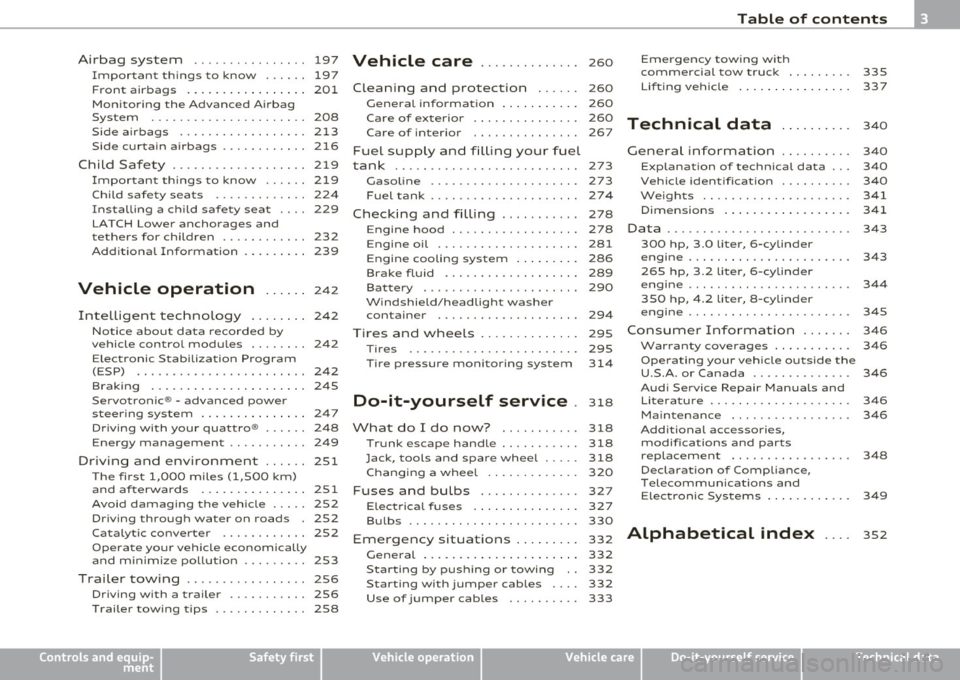
Airbag system ................ 197
Important things to know ...... 197
Front airbags ......... ........ 201
Monitoring the Advanced A irbag
System ...................... 208
Side airbags .................. 213
Side curtain a irbags . . . . . . . . . . . . 216
Child Safety ................... 219
Impor tant things to know ..... .
Child safety seats ............ .
Installing a child safety seat ... .
LATCH Lowe r anchorages and
tethers for children ........... .
Add it ional Informat ion 219
224
229
232
239
Vehicle operation
...... 24 2
Intelligent technology . . . . . . . . 242
Notice abou t data recorded by
vehicle control modules . . . . . . . . 242
E lectronic Stab iliza tion Program
(ESP) ........................ 242
Braking . . . . . . . . . . . . . . . . . . . . . . 245
Servo tronic® -advanced power
steering system .......... ..... 247
Driving with your quattro® . . . . . . 248
Energy management . . . . . . . . . . . 249
Driving and environment ...... 251
T he first 1,000 miles (1,500 km)
and afterwards . ............. . 251
Avoid damaging the vehicle . . . . . 252
Driving through water on roads . 252
Catalytic converter . . . . . . . . . . . . 252
Operate your veh icle econom ically
and minimize pollution . . . . . . . . . 253
Trailer towing ................. 256
Driving with a trailer . . . . . . . . . . . 256
T railer towing tips . . . . . . . . . . . . . 258
Controls and equip
ment Safety first
Vehicle care
.............. 260
Cleaning and protection ...... 260
General informa tion . . . . . . . . . . . 260
Care of exterior . . . . . . . . . . . . . . . 260
Care of interior . . . . . . . . . . . . . . . 267
Fuel supply and filling your fuel
tank ..........................
273
Gasoline . . . . . . . . . . . . . . . . . . . . . 273
Fuel tank ..................... 274
Checking and filling . . . . . . . . . . . 278
Engine hood . . . . . . . . . . . . . . . . . . 278
Engine oil . . . . . . . . . . . . . . . . . . . . 281
Engine cooling system . . . . . . . . . 286
Brake fluid . . . . . . . . . . . . . . . . . . . 289
Battery . . . . . . . . . . . . . . . . . . . . . . 290
Windshield/headlight washer container . . . . . . . . . . . . . . . . . . . . 294
Tires and wheels . . . . . . . . . . . . . . 295
T ires ........................ 295
T ire pressure monitoring system 314
Do-it-yourself service . 318
What do I do now? ........... 318
T runk escape handle ........... 318
Jack, tools and spare wheel ..... 318
Changing a wheel . . . . . . . . . . . . . 320
Fuses and bulbs . . . . . . . . . . . . . . 327
E lectrical fuses ............... 327
Bulbs ........................ 330
Emergency situations . . . . . . . . . 332
General . . . . . . . . . . . . . . . . . . . . . . 332
Starting by pushing or towing 332
Starting with jumper cables . . . . 332
Use of jumper cables . . . . . . . . . . 333
Table of contents
Eme rgency towing with
commercial tow truck ........ .
Lift ing vehicle ............... .
Technical data
General information
Explanation of technic al data .. .
Vehicle ident ification ......... .
Weights ................... . .
Dimensions ............... .. .
Data ......................... .
300 hp, 3.0 lite r, 6-cylinder
engine .................... .. .
265 hp, 3.2 liter , 6-cylinder
engine .. .......... .......... .
350 hp, 4.2 liter, 8-cylinder
engine ...... .............. .. .
Consumer Information ...... .
Warranty coverages .......... .
Operating your vehicle outside the
U.S.A. or Canada ............. .
Audi Service Repair Manuals and Li terature ................... .
Maintenance ........... ..... .
Additional accessories, modifications and parts
replacement ............... . .
Declaration of Compliance,
Telecommun ications and
E lectronic Systems .......... . .
Alphabetical index ... .
335
337
340
340
340
340
341
341
343
343
344
345
346
346
346
346
346
348
349
3S2
Vehicle operation Vehicle care Do-it-yourself service Technical data
Page 15 of 370
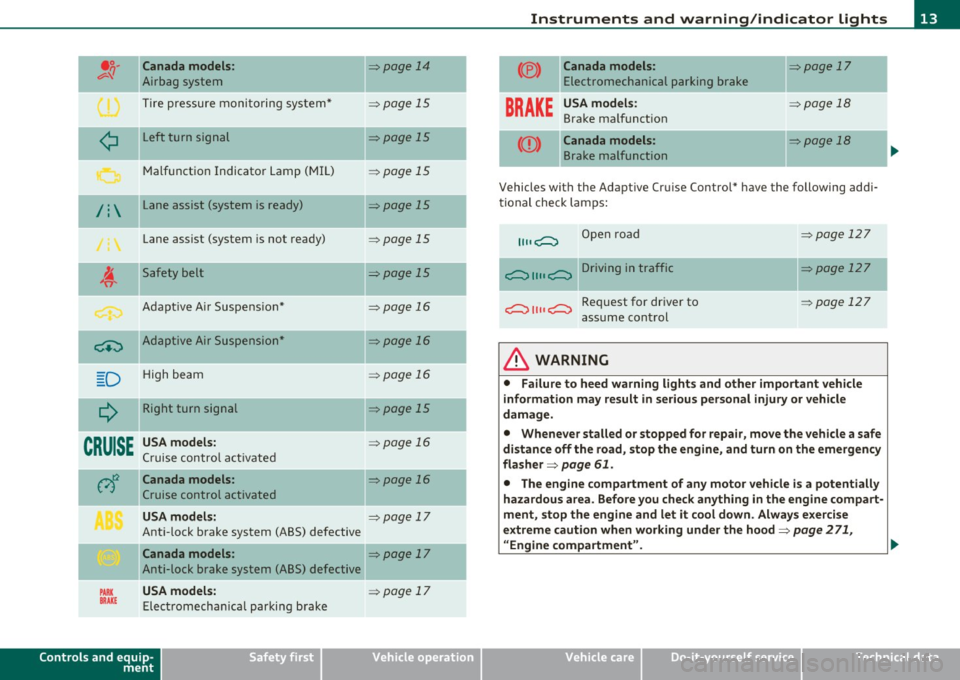
Canada models:
Airbag system
Tire pressure monitoring system*
L eft turn signal
Malfunct ion Indicator Lamp (MIL)
/ : Lane assist (system is ready)
Lane assist (system is not ready)
Safety belt
Adapt ive A ir Suspe nsio n*
-~ Adaptive Air Suspension"
D H igh beam
--
Q Right turn signal
CRUISE USA models:
Cruise contro l a ct ivate d =>page
14
=> page 15
=>page 15
=> page 15
=> page 15
=> page 15
=>page 15
=> page 16
=> page 16
=> page 16
=> page 15
=>page 16
Canada models: => page 16
Cruise control activated
USA models: => page 17
Ant i-lock brake system (ABS) defective
Canada models : => page 17
Anti-lock brake system (ABS) defective
USA models: PARK BRAKE Elect romecha nica l parki ng b rake
Controls and equip
ment Safety first
=:::, page 17
-
-
-
Instruments and warning
/indicator lights
(®)
BRAKE
--
Canada models: => page 17
E lectromechanical parking brake
USA model s: => page 18
Brake ma lf u nct ion
-Canada models: => page 18
B rake malfunction
Vehicles with the Adaptive Cru ise Control* have the following addi
ti onal check lamps:
Open road
i;:;::::::, 1111 i;:;::::::, D ri vi n g i n traffic
i;:;::::::, 1111 i;:;::::::, Request for dr iver to
assume con trol
& WARNING
=> page 12 7
=:::, page 127
=> page 127
• Failure to heed warning light s and other important vehicle
information may result in s erious personal injury or vehicle
damage.
• Whenever stalled or stopped for repair, move the vehicle a safe
distan ce off the road, st op the engine, and turn on the emergency
flasher =>
page 61.
• The engine compartment of any motor vehicle i s a potentially
hazardous area . Befo re you check anyth ing in the engine compart
ment, stop the engine and let it cool down. Always exercise
extreme caution when working under the hood=>
page 2 71,
"Engine compartment". .,.
Vehicle care Technical data
Page 17 of 370
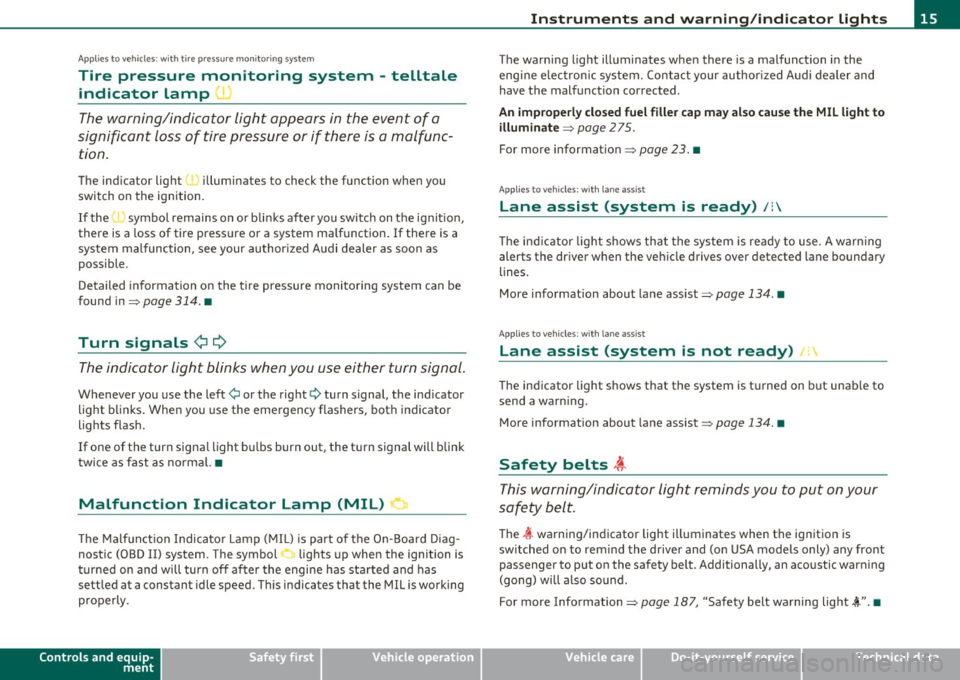
App lies to vehicl es: wi th t ir e pr essure mon it o ring system
Tire pressure monitoring system - telltale
indicator Lamp '
The warning/indicator light appears in the event of a
significant loss of tire pressure or if there is a malfunc
tion .
The indicator light 'J illuminates to check the func tion when you
switch on the ignition.
If the
I symbol remains on or blinks after you sw itch on the ignit ion,
there is a loss of tire pressure or a system malfunction . If there is a
system malfunction, see your author ized Audi dealer as soon as
possible.
Detailed information on the tire pressure monitoring system can be
found in=>
page 314. •
Turn signals ¢ ¢
The indicator light blinks when you use either turn signal.
Whenever you use the left¢ or the right¢ turn signal, the indicator
light blinks. When you use the emergency flashers, both indicator
lights flash .
If one of the turn signa l light bu lbs burn out, the turn signal will blink
twice as fast as normal. •
Malfunction Indicator Lamp (MIL) !'.I
The Malfunct ion Indicator Lamp ( MIL) is part of the On-Board Diag
nostic (OBD II) system . The symbol lights up when the ignition is
t u rned on and will turn off after the engi ne has started and has
sett led at a constant idle speed. This indicates that the MIL is working
properly .
Controls and equip
ment Safety first
In
strum ents and warning /indicator lights
The warning light illuminates when there is a malfunction in the
engine electron ic system. Contact your author ized Audi dealer and
have the malfunction corrected .
An imp rope rly clo sed fu el fille r cap ma y al so cau se the M IL l ight to
illum in ate =>
page 2 75.
For more information=> page 23. •
App lies to vehicles : w ith lane ass ist
Lane assist (system is ready) /:
T he ind icator light shows that the system is ready to use . A warn ing
aler ts the driver when the veh icle drives over de tected lane boundary
lines.
More information about lane assist=>
page 134. •
Applies to vehi cles : wit h lane assis t
Lane assist (system is not ready) I
The indicator light shows that the system is turned on but unab le to
send a warn ing .
Mo re information about lane assist =>
page 134. •
Safety belts ,i
This warning/indicator light reminds you to put on your
safety belt.
The 4t warning/indicator light illuminat es when th e ignition is
switched on to rem ind the d river and (on USA models only) any front
pass enger to put on the safety b elt. Add itionally, an acoustic wa rning
(gong) will a lso sound.
For more Information=>
page 187, "Safety belt warning light~".•
Vehicle care Technical data
Page 21 of 370

Driver information display
Introduction
General notes
The driver information display inside the instrument
cluster provides you, the driver, with much useful infor
mation .
Fig. 8 Instrument
cluster: center display
Informat ion from the Driver Information System is shown in the
display in the center of the instrument cluster.
When you tu rn on the ignition and while you are driving, some func
tions and vehicle components are scanned for their operating status.
Malfunctions or required service procedures are signalled audibly and
shown by red and yellow lighted symbols and reminders to the driver
in the display .
Th e driver is also shown information about radio and CD operat ion
and directions for the navigation system. You can find additional
information on these subjects in the MMI manual.
The Driver Information System provides the follow ing functions:
Con tro ls a nd e quip
m en t Vehicle
OP-eration
Driver information display
Sound system display ~page20
Outside a ir temperature ~page20
Digital speedometer ~ page21
Door open indicator ~page21
Defective light bulb ~page21
Service interval display ~page22
Auto Check system ~page24
Driver information ~page24
Speed limiter ~page23
Trip computer ~ page3 4
Tire pressure monitoring ~page314
Selector lever position ~ page 147
(I] Tips
In the event of a malfunction either a red or yellow icon appears in the
display . Red symbols indicate
Danger ~ page 25. Yellow symbols
indicate a
Warning ~ page 29. •
Vehicle care Do-it-yourselt service iTechnical data
Page 26 of 370
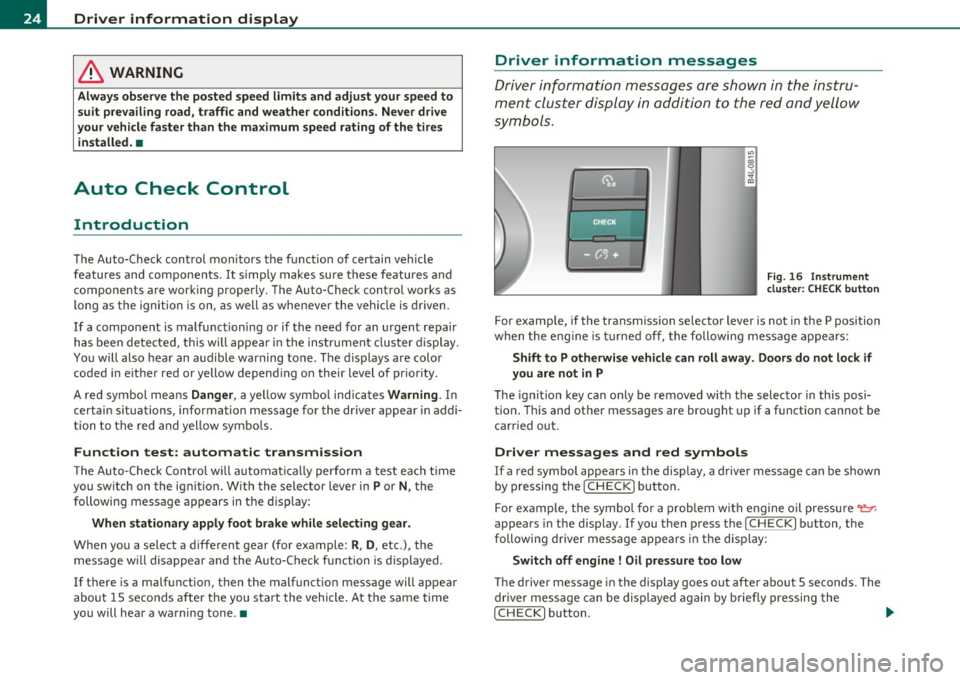
Driver information display
in. WARNING
Always observe the posted speed limits and adjust your speed to
s uit prevailing road, traffic and weather condition s. Never drive
your vehicle fa ster than the maximum speed rating of the tires
installed. •
Auto Check Control
Introduction
The Auto-Check control monitors the function o f ce rtain vehicle
featu res and components.
It simp ly makes su re t hese featu res and
components are work ing properly. The Auto-Check control works as
long as the ignition is on, as we ll as whe neve r th e veh icle is d riven.
If a component is malfu nctioning or if the need for an urgent repair
has been de tected, this wi ll appear in t he instrument clus ter display .
Yo u will also hea r an a udible warning to ne. The disp lays are colo r
coded in e ither red or yellow depend ing on their level of prior ity.
A red symbo l me ans
Danger , a yellow sym bol indic ates Warning . In
certain situations, information message for the driver appear in addi
t ion to the red and yellow sym bols.
Function test: automatic transmission
T he Auto-Check Contro l w ill a uto matic ally perform a test each t ime
you switch on the ignit ion. W ith the selector lever in
P or N , the
f ollowin g messa ge a ppears in the displ ay :
When stationary apply foot brake while selecting gear .
When you a se lect a d ifferent gear (for example : R, D , etc .), the
message w ill disappea r and the Au to-C hec k function is d isp layed.
If there is a ma lfunction, then the malfunct ion message will appear
a bou t 15 seco nds after t he you st art the vehicle . At t he same time
you will hea r a wa rn ing tone .•
Driver information messages
Dr ive r inf orm ation messa ges a re show n in the instru
men t clust er dis play i n addition to the red a nd yell ow
sym bols .
Fig . 16 In st rument
cluste r: CHE CK button
For examp le, if the transmiss ion se lector lever is not in the P position
w hen the eng ine is tu rne d off, the following mess age app ears :
Shift to P otherwise vehicle can roll away. Doors do not lock if
you are not in P
Th e ig nit io n key can on ly be removed w ith t he selecto r in this posi
tion. This and other messages are brought up if a funct io n cannot be
c arr ied out.
Driver messages and red symbols
If a red symbol appears in the disp lay, a dr ive r message can be s hown
by pressing the [ CHECK] button .
F or e xample, t he symbol for a prob lem w ith e ngine oil press ure
'l:::r.
appea rs in the display. If you t hen p ress the I CHECK ] b utton, the
f ollowi ng dr iver me ss a ge ap pea rs in t he disp lay:
Switch off engine ! Oil pressure too low
The driver message in the display goes out afte r abo ut 5 seconds . The
dr ive r mes sage can be di spla yed a gain by b riefly p ressing the
[CHECK ] button. .,,.
Page 32 of 370
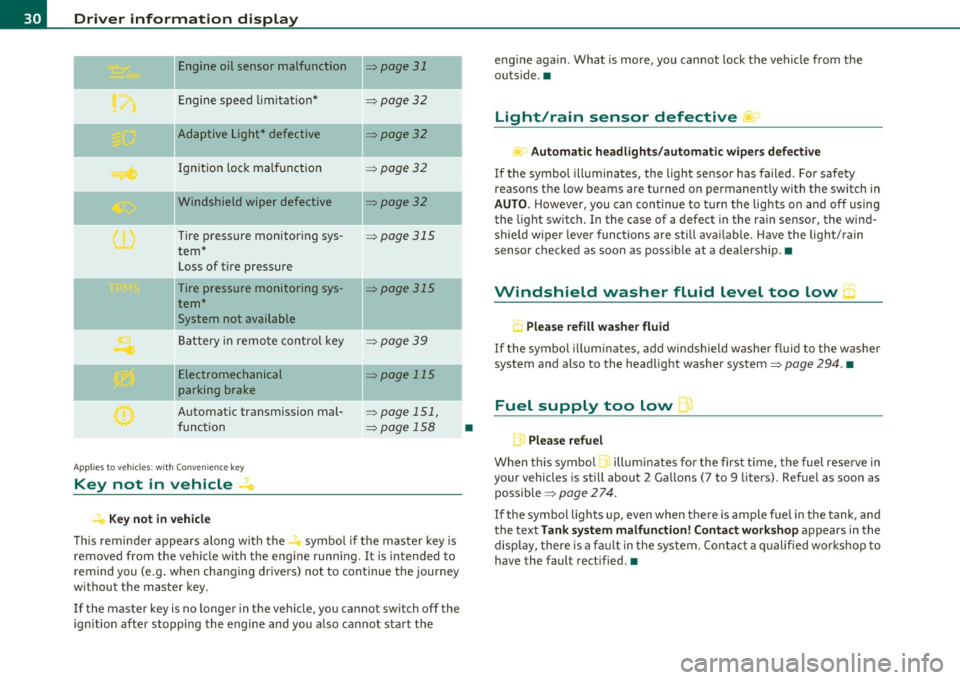
Driver information display
Engine oil sensor malfunction => page 31
._ --
Engine speed limitation* :::>page 32
-- -Adaptive Light* defective => page 32
Ignition lock malfunction =>page 32
--Windshield wiper defective => page 32
Tire pressure monitoring sys
tem*
Loss of tire pressure
Tire pressure monitoring sys
tem*
System not available
Battery in remote control key
--
=> page 315
=> page 315
:::>page 39
Electromechanical => page 115
parking brake
Automatic transmission mal
function
Ap plies to vehicles: w ith Conven ience key
Key not in vehicle
Key not in vehicle
=> page 151,
=> page 158
-
-
This reminder appears along with the...., symbol if the master key is
removed from the vehicle with the engine running. It is intended to
remind you (e.g. when changing drivers) not to continue the journey
without the master key.
If the master key is no longer in the vehicle, you cannot switch off the
ignition after stopping the engine and you also cannot start the
•
engine again . What is more, you cannot lock the vehicle from the
outside. •
Light/rain sensor defective )
Automatic headlights/automatic wipers defective
If the symbol illuminates, the light sensor has failed . For safety
reaso ns the low beams are turned on permanently with the switch in
AUTO. However, you can continue to turn the lights on and off using
the light switch. In the case of a defect in the rain sensor, the wind
shield wiper lever functions are still available. Have the light/rain
sensor checked as soon as possible at a dealership. •
Windshield washer fluid level too low 5
, Please refill washer fluid
If the symbol illuminates, add windshield washer fluid to the washer
system and also to the headlight washer system=>
page 294. •
Fuel supply too low )
L Please refuel
When this symbol 1. illuminates for the first time, the fuel reserve in
your vehicles is still about 2 Gallons (7 to 9 liters). Refuel as soon as
possible =>
page 274.
If the symbol lights up, even when there is ample fuel in the tank, and
the text
Tank system malfunction! Contact workshop appears in the
display, there is a fault in the system . Contact a qualified workshop to
have the fault rectified.•
Page 179 of 370

Driving Safely ---------------------"~'----
Important things to do before driving
Safety is everybody's job! Vehicle and occupant safety
always depends on the informed and careful driver.
For your safety and the safety of your passengers, before
driving always:
- Make sure that all lights and signals are operating
correctly.
- Make sure that the tire pressure is correct.
- Make sure that all windows are clean and afford good visi-
bility to the outside.
- Secure all luggage and other items carefully::::>
page 93.
-Make sure that nothing can interfere with the pedals.
- Adjust front seat, head restraint and mirrors correctly for your height .
- Instruct passengers to adjust the head restraints according to their height.
- Make sure to use the right child restraint correctly to
protect children ::::,
page 219, "Child Safety".
- Sit properly in your seat and make sure that your passen gers do the same::::,
page 75, "General recommenda
tions".
- Fasten your safety belt and wear it properly. Also instruct
your passengers to fasten their safety belts properly
=:> page 187. •
Controls and equip
ment Safety first Vehicle operation
What impairs driving safety?
Safe driving is directly related to the condition of the
vehicle, the driver as well as the driver's ability to concen
trate on the road without being distracted .
The driver is responsible for the safety of the vehicle and all
of its occupants. If your ability to drive is impaired, safety
risks for everybody in the vehicle increase and you also
become a hazard to everyone else on the road::::,,& . There
fore:
Do not let yourself be distracted by passengers or by using
a cellular telephone.
NEVER drive when your driving ability is impaired (by
medications, alcohol, drugs, etc.).
- Observe all traffic laws, rules of the road and speed limits
and plain common sense .
- ALWAYS adjust your speed to road, traffic and weather
conditions.
- Take frequent breaks on long trips. Do not drive for more than two hours at a stretch.
- Do NOT drive when you are tired, under pressure or when
you are stressed .
& WARNING
Impaired driving safety increases the risk of serious personal
injury and death whenever a vehicle is being used.•
Vehicle care Do-it-yourself service Technical data
Page 186 of 370
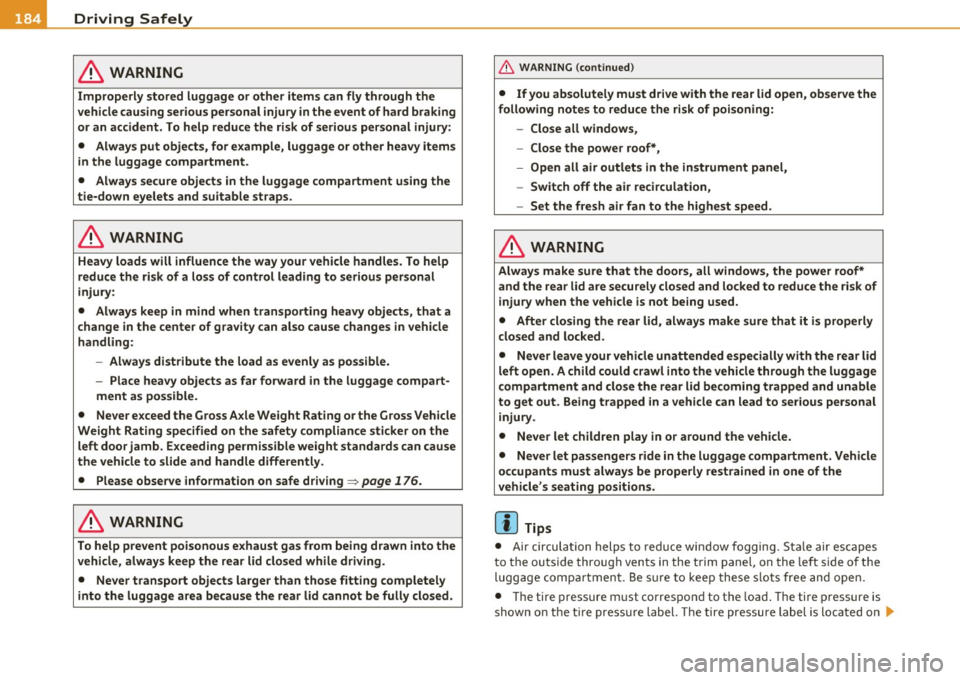
• ....__D_ r_iv _i_ n_, g=-- S_ a _ f_e _,Ly _ ______________________________________________ _
in. WARNING
Improperly stored luggage or other items can fly through th e
vehicle c au sing seriou s per sonal injury in the event of hard braking
or an accident . To h elp reduce the risk of serious personal injury :
• Always put objects, for examp le, luggage or other heavy items
in the luggag e compartment .
• Alway s secure objects in the luggage compartment using the
tie -down eyelets and suitable straps.
& WARNING
Heavy loads will influence the way your vehicle handles. To help
reduce the ri sk of a loss of control leading to seriou s personal
injury:
• Always keep in mind when tran sporting heavy objects, that a
c hange in the center of gr avity can also cause changes in vehicle
handling:
-Always di stribute the load as evenly as po ssible.
- Place heavy objects as far forward in the luggage compart-
ment as po ssible.
• Never e xceed the Gross Axle Weight Rating or the Gross Vehicle
Weight Rating specified on the safety compliance sticker on the
left door jamb . Exceeding permissible weight standards can cause
the vehicle to slide and handle differently .
• Please observe information on safe driving =>
page 176 .
in. WARNING
To help prevent poisonous exhaust gas from being drawn into the
vehicle, always keep the rear lid closed while driving.
• Never transport objects larger than those fitting completely
into the luggage area because the rear lid cannot be fully closed.
& WARNING (c on tinued )
• If you absolutely must drive with the rear lid open , ob serve the
following note s to reduce the risk of poisoning:
- Close all windows ,
- Close the power roof*,
- Open all air outlet s in the instrument panel,
- Switch off the air recirculation ,
- Set th e fresh air fan to the high est speed .
in. WARNING
Always make sure that the doo rs , all windows, the power roof*
and the rear lid are securely clo sed and locked to reduce the risk of
i njury when the vehicle is not be ing used.
• After closing the rear lid, always make sure that it is properly
closed and locked.
• Never leave your vehicle unattended especially with the rear lid
left open. A child could c rawl into the vehicle through the luggage
c ompartment and clo se the rear lid becoming trapped and unable
to get out . Being trapped in a vehicle can lead to serious personal
injury.
• Never let children play in or around the vehicle.
• Never l et pa ssengers ride in the luggage compartment. Vehicle
occupants must always be properly restrained in one of the
vehicle 's seating positions .
(I) Tips
• Air circulation helps to re d uce win dow fogging. Sta le air es capes
to the outside through vents in the trim panel, on the left s ide of the
lugg age compa rtmen t. B e sur e to keep these s lots free and ope n.
• Th e tire pressure m ust correspond to the load . The tire pressure is
shown o n the tir e pressu re label. The tire pressu re label is loc ated o n .,_
Page 187 of 370

________________________________________________ D_ r_ i_ v _i_n ""'g "-- S_a_ f_ e_ l _,,y'-- __
the dr iver's side 8-p illar (v isib le when the door is open). The tire pres
s u re label lists t he recommen d end cold t ire infl ation pressures fo r
the vehicle at its maximum capacity weight and t he tires that were on
yo ur vehicle at the time it was ma nufact ured. For recommended ti re
pressures for normal load cond it ions, please see chapter
=> page 299. •
Tie-downs
The luggage compartment is equi pped with f our tie
downs to secur e luggage and other items.
Use the t ie-downs to sec ure yo ur cargo prope rly => page 183,
"Load ing the luggage compartment" .
In a co llision, the laws of physics mean that even sma ller items that
are loose i n the vehicle will become heavy m issiles t hat can c ause
serious injury. Items in the vehicle possess energy wh ich vary w ith
vehicle speed and the we igh t o f the i tem. Vehi cle spee d is t he m ost
significant factor.
For examp le, in a frontal coll ision at a spee d of 30 mph (48 km/h),
the forces acting on a 10- lb (4 .5 kg) object are abo ut 20 times the
normal weight of the item . T his means that t he weight of t he item
wou ld s uddenly be abo ut 200 lbs. (90 kg). You can imagine the inju
r ies that a 200 lbs . (90 kg) item flying free ly throug h the passenge r
c ompa rtmen t cou ld cause in a collision lik e this.
& WARNING
Weak, damaged or improper straps used to secure items to tie
downs can fail during hard braking or in a collision and cause
serious personal injury .
• Always use suitable mounting strap s and prope rly secure items
to the tie -downs in the luggage compartment to help prevent
items from shifting or flying forward as dangerous missiles.
• When the rear seat backrest is folded down, always use suit
able mounting straps and properly secure items to the tie-downs
Controls and equip ment Safety first Vehicle operation
& WARNING
(co ntinued )
in the luggage compartment to help prevent items from flying
forward as dangerous missil es into the passenger compartment.
• Never attach a child safety seat tether strap to a tie -down. •
Reporting Safety Defects
Applicable to U.S.A.
If you belie ve that your veh icle has a defect
which could cause a crash or could cause injury
or death , you should immediately inform the
National Highway Traffic Safety Admini stration
(NHTSA) in addition to notifying Audi of
America, Inc.
If NHTSA receives similar complaints, it may
open an investig ation, and if it find s that a
safety d efe cts exist s in a group of vehicle s, it
ma y order a rec all and remedy campaign.
However , NHTSA cannot become involved in
individual problems between you , your dealer,
or Audi of America , Inc.
To contact NHTSA , you may call th e Vehicle
Safety Hotline toll-free at:
Tel.: 1-888-327-4236 (TTY: 1-800-424-9153)
or write to:
Administrator
Vehicle care Do-it-yourself service Technical data
Page 245 of 370

Intelligent technology
--------------------------------------------------' '----'----
fore-and-aft and lateral directions, the brake pressure and the
steering angle are all measured.
The direction in which the driver wishes to travel is determined with
the aid of the steering angle and vehicle speed and is continually
compared with the actual behavior of the vehicle. If the two do not
match, for example , when the vehicle starts hydroplaning on a wet
road, ESP will automatically brake the appropriate wheel to correct
the problem.
The vehicle is then stabilized by the forces acting on the wheel during
braking. If the vehicle is
oversteering (rear tends to skid out of the
turn), the brakes are mainly applied on the wheel that is on the
outside of the curve. In the case of a vehicle that is
understeering
(tendency to slide out of the curve), the brakes are applied at the rear
wheel that is on the inside of the curve. An acoustic signal indicates
when ESP brake application cuts in =>
&.
The system operates across the entire speed range in combination
with the ABS system=>
page 246. If the Anti-Lock Brake System
(ABS) malfunctions, the ESP will be out of action as well.
Activating
When you turn on the engine, ESP will automatically be activated and
will perform a self-test . As soon as the test is completed, the system
is in normal operating mode.
You can activate a deactivated ESP or deactivated ESP/ ASR if required
by pressing the=>
page 242, fig. 201 button. When they are acti
vated, the message
ESP/ASR on appears briefly in the display .
Deactivating
The ESP should normally be activated all the time. If necessary , you
can deactivate Anti-Slip Regulation (ASR) or the Electronic Stabiliza
tion Program (ESP) by pressing the button =>
page 242, fig. 201.
• Deactivating ASR: Tap the but ton . In certain excep tional situa
tions (e.g. driving with tire chains) , the Anti-Slip Regulation (ASR) can
be deactivated=>
page 244 . The message ASR off appears in the
display as well.
Controls and equip ment Safety first Vehicle operation •
Deactivating ESP/ASR
Press the button for more than 3 seconds .
With the ESP/ASR deactivated, the ESP check light comes on, see
=>
page 14. The message ESP switched off appears in the display as
well.
& WARNING
The Electronic Stabilization Program is nevertheless subject to the laws of physics. It is particularly important to pay attention to
this fact on wet and slippery roads. It is therefore important that
you always adapt your driving to the condition of the road and traffic conditions. Do not allow the increased safety provided by
the Electronic Stabilization Program system to lull you into
accepting additional safety risks. •
Electronic differential lock (EDL)
The electronic differential lock monitors the rotational
speed of the drive wheels.
General notes
The electronic differential lock (EDL) helps the car to start moving,
accelerate and climb a gradient on surfaces providing poor or almost
no grip . Without EDL, this would be difficult, if not impossible .
How the system works
The EDL operates automatically . It monitors the rotational speed of
the drive wheels on an axle with the help of the ABS sensors
=>
page 246 . If a noticeable difference in rotational speed between
the drive wheels on one axle is detected (e.g. on slippery ground
on
one side),
the spinning wheel is braked, thereby transferring power to
the othe r drive wheel or wheels (all-wheel drive). This is done up to a
speed of about 60 mph (100 km/h) . Noises from the brake system
signal that wheel spin is being controlled.
Vehicle care Do-it-yourself service Technical data